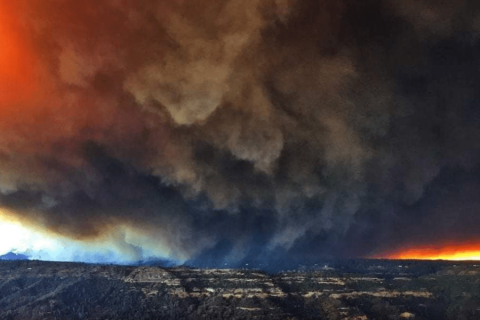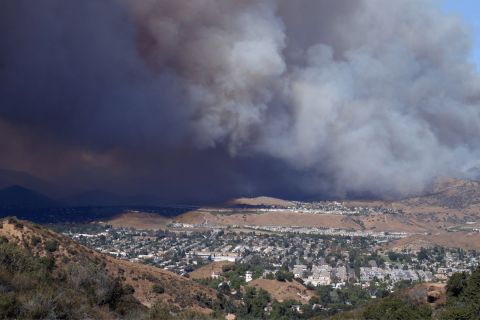
Wildfires
The Office of Environmental Health Hazard Assessment (OEHHA) researches and presents information related to wildfires and its health effects including development of guidance and fact sheets, epidemiological research, and measurement of wildfire as a climate change indicator.
These resources developed or co-developed by OEHHA, are designed to help local public health officials prepare for smoke events, to take measures to protect the public when smoke is present, and to communicate with the public about wildfire smoke and health.
OEHHA hosts symposia on key emerging issues relevant to state scientists and policy makers in the field of wildfire smoke and public health.
Climate Change Indicators: Wildfires and Wildfire Smoke
The increasing number and intensity of wildfires are an indicator of climate change, which are scientific measurements that track trends and conditions relating to climate change.
OEHHA has published multiple epidemiological studies evaluating the health effects of wildfires
Wildfire Smoke Guidance
OEHHA develops guidance and co-authors factsheets related to wildfire smoke.
Wildfire Smoke: A Guide For Public Health Officials Revised 2019 August 22, 2019. This guide is designed to help local public health officials prepare for smoke events, to take measures to protect the public when smoke is present, and to communicate with the public about wildfire smoke and health.
Wildfire Guide Post-Publication Updates | AirNow.gov This web page is for Wildfire Guide authors and contributors, including OEHHA, to post fact sheets, web links, and other new information developed since 2019. This information will also be used in the next update to the Guide. The goal is to provide public health officials with the latest information between revisions of the Guide.
Wildfire Smoke - Guidance for Schools During Wildfire Smoke Events (Factsheet: November 2019) Severe wildfires of the past few years have resulted in impacts to schools across California. This OEHHA fact sheet is intended for school administrators, school districts, parents, the general public, local public health officials, and local air districts.OEHHA developed this factsheet with recommendations to assist schools in decisions related to:
- Reducing outdoor activities
- Protecting the health of sensitive students
- Improving indoor air quality
- Considering school closure
- Preparing for school reopening and cleanup
Protecting Public health from Home and Building Fire Ash Fact Sheet Safe methods of fire ash cleanup and the hazards associated with exposure. This report summarizes safe methods of ash cleanup. All persons accessing burned structures should be aware of the hazards associated with those sites. Cleanup efforts may expose you to ash, soot, and fire decomposition products that may cause irritation and other health effects. Any ash may contain small amounts of cancer-causing chemicals.
Protecting Children from Wildfire Smoke and Ash Fact Sheet (airnow.gov) Learn how to protect children from wildfire smoke and ash.
Protect Your Lungs from Wildfire Smoke Fact Sheet (airnow.gov) Learn the most effective ways to keep smoke and ash from getting into your lungs.
Protect Yourself from Ash Fact Sheet (airnow.gov) Learn how to protect yourself from ash due to wildfires.
Prepare For Fire Season Fact Sheet (airnow.gov) Be ready to reduce your smoke exposure before fire season.
Reduce Your Smoke Exposure Fact Sheet (airnow.gov) Learn how to reduce your smoke exposure, both indoors and outdoors, on smoky days.
At-Risk Groups of People (airnow.gov) Learn who is at greater risk from smoke.
Coping with the Stress of Wildfire Smoke Fact Sheet (airnow.gov) ways to cope with the stress of wildfire smoke exposure.
Protect Yourself from Smoke and Extreme Heat (airnow.gov) This fact sheet includes information about actions you can take to protect yourself and your family from wildfire smoke and extreme heat.
For additional resources, see CalEPA's page on Fire Response and Recovery | CalEPA
Wildfire Smoke Symposia
These symposia help keep our state scientists at the forefront of science and policy and provide a forum for interaction between state scientists and researchers on cutting edge issues related to wildfire smoke toxicity and interventions.
Wildfire Smoke Interventions: Respirators and Public Health
June 26, 2024 - The symposium focused on improving our understanding of key recommendations for protecting vulnerable populations from wildfire smoke, in support of AB 619. Dr. Stephanie Holm of the Western States Pediatric Environmental Health Specialty Unit at UCSF, Dr. Fiona McDonald of Queensland University of Technology, and Dr. Francisca Santana of the University of Washington each discussed research related to special considerations around respirator use when it comes to wildfire smoke.
Wildfire Smoke Toxicity & Public Health
October 4, 2024 - Dr. Luke Montrose of Colorado State University, Dr. Lisa Miller of UC Davis, and Dr. Scott Fendorf of Stanford University each presented research related to wildfire smoke toxicity, components of wildfire smoke, and how wildfire smoke compares to ambient air pollution.
Climate Change Indicators
The fourth edition of OEHHA’s Indicators of Climate Change in California report documents observed changes in the state’s climate and its impacts in the state. Indicators are scientific measurements that track trends and conditions relating to climate change. Two of these indicators directly relate to wildfires.
![]()
Climate Change and Wildfires
Wildfires are a natural part of California's landscape where much of the state’s forests are adapted to periodic burning. This natural pattern has been significantly altered by land use, fire management practices, and a changing climate. An increase in the number and severity of large wildfires throughout the western United States is linked to hotter and drier conditions. Scientists caution that California and the western US have entered an era of "mega-fires".
![]()
Climate Change and Wildfire Smoke
As a warming climate fuels wildfires in California, human and environmental exposures to harmful air pollutants are increasing. Wildfire smoke is a complex mixture of toxic gases, fine particulate matter, and other pollutants linked to respiratory illnesses and other health effects. Scientists can estimate potential population exposures using satellite imagery of smoke plumes. Satellite-detected smoke plumes often co-occur with higher concentrations of fine particulate matter (2.5 microns or less in diameter, or PM2.5)
Wildfire Research
OEHHA has published several studies evaluating the health effects of wildfires. The findings consistently indicated that exposure to wildfire PM2.5 increased the risk of respiratory emergency room visits and hospital admissions, particularly among people of color, elderly populations, outdoor workers, children, and other vulnerable populations. Rural and tribal populations, who are generally most physically closest to wildfires, often lack resources such as easy access to healthcare, food and emergency supply centers, and multiple means of transportation that can help them escape fire more quickly.
Furthermore, findings suggested that PM2.5 during the wildfire periods may contain more toxic chemical constituents than during non-wildfire periods. For instance, wildfire often straddles the wildland-urban interface, meaning plastics, finished wood products, and other human-made materials from homes can burn and let off volatile organic compounds (VOCs) that are especially toxic to humans. Tree species, particularly evergreen varieties like certain pines, can also be toxic when burning. Because of worsening drought, these types of trees, which are especially susceptible to desiccation and death due to lack of moisture, tend to burn faster than deciduous trees, particularly when in declining health.
In addition to respiratory and cardiovascular health effects from wildfire, a growing body of literature also highlights the decline in mental health and well-being populations feel from recurring threats of wildfire occurring year after year. Those living closest to rural areas where wildfire often start face the highest risk. These same populations also face added stress from finding affordable fire insurance, maintaining their properties or risking fines, and declining property values as risk of fire in their neighborhoods increase. Ash from wildfire can also pollute water sources, creating added health crises for already-burdened populations. Trees still left standing but damaged from wildfire become susceptible to failure during winter storms, adding to the stress property owners face from wildfire itself. Thus, health effects from wildfire are often multi-factorial and extend far beyond the immediate aftermath of the event itself.



